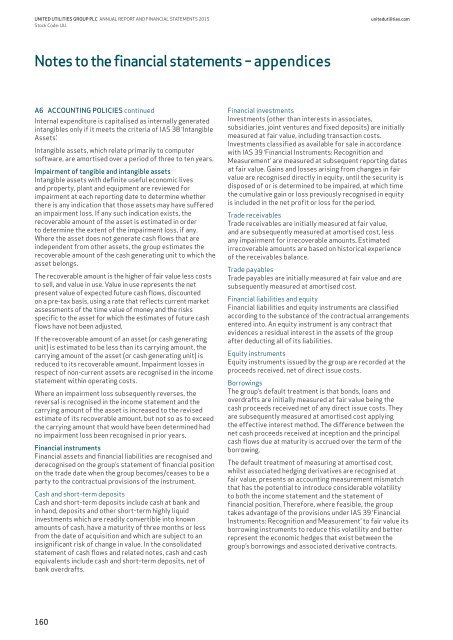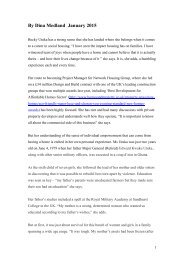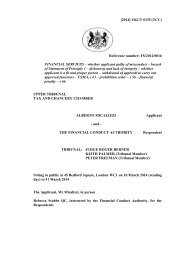united-utilities-annual-report-2015
united-utilities-annual-report-2015
united-utilities-annual-report-2015
Create successful ePaper yourself
Turn your PDF publications into a flip-book with our unique Google optimized e-Paper software.
UNITED UTILITIES GROUP PLC ANNUAL REPORT AND FINANCIAL STATEMENTS <strong>2015</strong>Stock Code: UU.<strong>united</strong><strong>utilities</strong>.comNotes to the financial statements – appendicesA6 ACCOUNTING POLICIES continuedInternal expenditure is capitalised as internally generatedintangibles only if it meets the criteria of IAS 38 ‘IntangibleAssets’.Intangible assets, which relate primarily to computersoftware, are amortised over a period of three to ten years.Impairment of tangible and intangible assetsIntangible assets with definite useful economic livesand property, plant and equipment are reviewed forimpairment at each <strong>report</strong>ing date to determine whetherthere is any indication that those assets may have sufferedan impairment loss. If any such indication exists, therecoverable amount of the asset is estimated in orderto determine the extent of the impairment loss, if any.Where the asset does not generate cash flows that areindependent from other assets, the group estimates therecoverable amount of the cash generating unit to which theasset belongs.The recoverable amount is the higher of fair value less coststo sell, and value in use. Value in use represents the netpresent value of expected future cash flows, discountedon a pre-tax basis, using a rate that reflects current marketassessments of the time value of money and the risksspecific to the asset for which the estimates of future cashflows have not been adjusted.If the recoverable amount of an asset (or cash generatingunit) is estimated to be less than its carrying amount, thecarrying amount of the asset (or cash generating unit) isreduced to its recoverable amount. Impairment losses inrespect of non-current assets are recognised in the incomestatement within operating costs.Where an impairment loss subsequently reverses, thereversal is recognised in the income statement and thecarrying amount of the asset is increased to the revisedestimate of its recoverable amount, but not so as to exceedthe carrying amount that would have been determined hadno impairment loss been recognised in prior years.Financial instrumentsFinancial assets and financial liabilities are recognised andderecognised on the group’s statement of financial positionon the trade date when the group becomes/ceases to be aparty to the contractual provisions of the instrument.Cash and short-term depositsCash and short-term deposits include cash at bank andin hand, deposits and other short-term highly liquidinvestments which are readily convertible into knownamounts of cash, have a maturity of three months or lessfrom the date of acquisition and which are subject to aninsignificant risk of change in value. In the consolidatedstatement of cash flows and related notes, cash and cashequivalents include cash and short-term deposits, net ofbank overdrafts.Financial investmentsInvestments (other than interests in associates,subsidiaries, joint ventures and fixed deposits) are initiallymeasured at fair value, including transaction costs.Investments classified as available for sale in accordancewith IAS 39 ‘Financial Instruments: Recognition andMeasurement’ are measured at subsequent <strong>report</strong>ing datesat fair value. Gains and losses arising from changes in fairvalue are recognised directly in equity, until the security isdisposed of or is determined to be impaired, at which timethe cumulative gain or loss previously recognised in equityis included in the net profit or loss for the period.Trade receivablesTrade receivables are initially measured at fair value,and are subsequently measured at amortised cost, lessany impairment for irrecoverable amounts. Estimatedirrecoverable amounts are based on historical experienceof the receivables balance.Trade payablesTrade payables are initially measured at fair value and aresubsequently measured at amortised cost.Financial liabilities and equityFinancial liabilities and equity instruments are classifiedaccording to the substance of the contractual arrangementsentered into. An equity instrument is any contract thatevidences a residual interest in the assets of the groupafter deducting all of its liabilities.Equity instrumentsEquity instruments issued by the group are recorded at theproceeds received, net of direct issue costs.BorrowingsThe group’s default treatment is that bonds, loans andoverdrafts are initially measured at fair value being thecash proceeds received net of any direct issue costs. Theyare subsequently measured at amortised cost applyingthe effective interest method. The difference between thenet cash proceeds received at inception and the principalcash flows due at maturity is accrued over the term of theborrowing.The default treatment of measuring at amortised cost,whilst associated hedging derivatives are recognised atfair value, presents an accounting measurement mismatchthat has the potential to introduce considerable volatilityto both the income statement and the statement offinancial position. Therefore, where feasible, the grouptakes advantage of the provisions under IAS 39 ‘FinancialInstruments: Recognition and Measurement’ to fair value itsborrowing instruments to reduce this volatility and betterrepresent the economic hedges that exist between thegroup’s borrowings and associated derivative contracts.160




